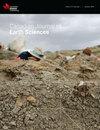Sulphide petrology and ore genesis of the stratabound Sheep Creek sediment-hosted Zn-Pb-Ag-Sn prospect, and U–Pb zircon constraints on the timing of magmatism in the northern Alaska Range
IF 1.6
4区 地球科学
Q3 GEOSCIENCES, MULTIDISCIPLINARY
引用次数: 0
Abstract
The Sheep Creek prospect is a stratabound Zn-Pb-Ag-Sn massive sulphide occurrence in the Bonnifield mining district, northern Alaska Range. The prospect is within a quartz-sericite-graphite-chlorite schist unit associated with Devonian carbonaceous and siliceous metasedimentary rocks. Volcanogenic massive sulphide (VMS) deposits in the district are hosted in felsic metavolcanic rocks (362 ± 2 Ma) associated with siliciclastic and carbonaceous sedimentary rocks that overlie the stratigraphic sequence hosting the Sheep Creek prospect. Felsic metaigneous rocks in underlying units are 372 ± 4 Ma to 366 ± 4 Ma. Sheep Creek is atypical of the other sulphide deposits in the district in (1) having Sn grades up to 1.2 %; (2) being contained in fine-grained, quartz-rich rocks and quartz-pebble conglomerate that likely originated as chert and chert-clast sediment, respectively; and (3) showing minimal evidence of volcanic components in the host rocks. Comparison of immobile trace-element proportions for graphitic and siliceous rocks from the Sheep Creek area with those for argillite associated with the Bonnifield VMS deposits indicates a continental volcanic-arc provenance for the former and a within-plate and passive margin provenance for the latter. In contrast to previously published interpretations, our data analysis supports a clastic-dominated (CD) rather than a VMS affinity for the Sheep Creek prospect. In our model, Zn-Pb-Ag-Sn mineralization formed by syngenetic or early diagenetic processes on or beneath the seafloor, possibly in the shallow-water environment of an outer continental shelf setting. Potential analogues are the Paleozoic CD deposits in the Canadian Selwyn Basin outboard of the Laurentian continental margin.绵羊溪地层沉积矿床的硫化物岩石学和矿石成因,以及阿拉斯加山脉北部岩浆活动时间的U-铅锆石制约因素
羊溪探矿区是阿拉斯加山脉北部邦尼菲尔德矿区的一个层状锌铅银锡块状硫化物矿区。探矿区位于石英-绢云母-石墨-绿泥石片岩单元内,与泥盆纪碳质和硅质变质岩伴生。该地区的火山成因块状硫化物(VMS)矿床赋存于与硅质沉积岩和碳质沉积岩伴生的长英质偏火山岩(362 ± 2 Ma)中,这些岩石是羊溪探矿区地层序列的上覆层。下伏岩层中的长粒新成岩为 372 ± 4 Ma 至 366 ± 4 Ma。与该地区的其他硫化物矿床相比,绵羊溪矿床具有以下特点:(1) 锡品位高达 1.2%;(2) 位于细粒、富含石英的岩石和石英卵石砾岩中,可能分别起源于白垩系和白垩系碎屑沉积物;(3) 主岩中火山成分的证据极少。将羊溪地区的石墨岩和硅质岩的不动痕量元素比例与邦尼菲尔德 VMS 矿床相关的箭云岩的不动痕量元素比例进行比较,结果表明前者的来源是大陆火山-弧,后者的来源是板块内和被动边缘。与之前公布的解释不同,我们的数据分析支持羊溪矿区以碎屑岩为主(CD),而非 VMS 亲缘。在我们的模型中,锌-铅-银-锰矿化是在海底或海底之下的合成或早期成岩过程中形成的,可能是在外大陆架的浅水环境中形成的。潜在的类似物是劳伦大陆边缘外侧加拿大塞尔温盆地的古生代 CD 矿床。
本文章由计算机程序翻译,如有差异,请以英文原文为准。
求助全文
约1分钟内获得全文
求助全文
来源期刊

Canadian Journal of Earth Sciences
地学-地球科学综合
CiteScore
2.80
自引率
7.10%
发文量
66
审稿时长
6-12 weeks
期刊介绍:
The Canadian Journal of Earth Sciences reports current research in climate and environmental geoscience; geoarchaeology and forensic geoscience; geochronology and geochemistry; geophysics; GIS and geomatics; hydrology; mineralogy and petrology; mining and engineering geology; ore deposits and economic geology; paleontology, petroleum geology and basin analysis; physical geography and Quaternary geoscience; planetary geoscience; sedimentology and stratigraphy; soil sciences; and structural geology and tectonics. It also publishes special issues that focus on information and studies about a particular segment of earth sciences.
 求助内容:
求助内容: 应助结果提醒方式:
应助结果提醒方式:


